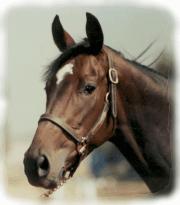A Horse, of Course with Don Blazer |
If you enjoy learning about horses, then you'll love our online courses. Each month you'll find a new column on our web site. We hope you'll enjoy it, and maybe e-mail us with questions or suggestions for other columns. A Horse, Of Course is a monthly column syndicated by Success Is Easy. If you like the column, call your local newspaper, or local horse publication and ask them to subscribe by contacting Success Is Easy. |
Poisonous Plants Don Blazer copyright©2012 |

As the drought continues,
the price of hay goes up, and when hay prices go up the number of horses poisoned
by contaminants in hay also increases. Bargain hay or hay cubes are no bargain if they kill your horses. As the price of hay goes up, according to a University of California study, the quality of the hay goes down and the amount of hay being fed is decreased. A horse that isn’t getting enough to eat, or is getting low quality hay looks for anything to munch on….too often deadly plants. It’s up to you to know how to identify plants in your area. In hay, the two most common are fiddleneck and groundsel. Fiddleneck is a problem only during the first cutting of a new stand of alfalfa. Groundsel can be a first-cutting contaminant in the second year, or even in older stands. On the west coast, Oleander accounts for numerous poisoned horses each year. Castor beans are another common killer of horses. The castor bean is found most often in the southern regions of the U.S. Other deadly plants are: Chokecherries, which are found most often in woods, prairies and orchards. They are large shrubs or trees and have pink and white flowers. Bladder pod, or rattlebox, which has flat pods and yellow flowers, is most common in the eastern and central states. Death camas grows in low grazing land and is frequently found in hay. Death camas is an herb with a grass-like leaf. Staggergrass or staggerbush is a spring and summer herb with a white, cone-shaped flower. Horses can get at it when they are being given a treat and allowed to graze in natural pastures. Horse nettle is a summer and fall plant that looks a lot like a tomato plant. Jimson weed is usually found in well-worn pastures, and Johnson grass is found all year long, especially in the south. Johnson grass is a coarse grass with a white vein. Ivybush is an eastern and northwestern shrub with a rose-colored flower. Laurel cherry is found in the southern regions. It has a heavy cherry odor. Milkweed grows all year long; especially along roadsides…it has a long silky pod and produces a milky sap. There are a number of sorghum grasses found throughout the U.S. Sudan grass is one common variety. Yellow star thistle is found in the west, while yellow jasmine is found in the east. Both are deadly. Water hemlock is a spring plant found in very wet open areas. The best way to avoid these poisonous plants is by not letting your horse nibble while going on trail rides. If you pasture your horse, check with your State Department of Agriculture for detailed information about poisonous plants in your area…then check the pasture carefully. Don’t buy bargain hay; buy from reputable dealers or feed stores. When you do buy hay, always open a bale or two and check it for contaminants. If you find a lot of foreign matter in the hay, reject it! Don’t accept anything you are not sure of….no matter how hard hay is to get. And upon the first signs your horse isn’t feeling well (showing signs of colic, stagger or extreme nervousness or tenseness) call your veterinarian. There is seldom a cure, but immediate attention can sometimes save a horse from plant poisoning. |